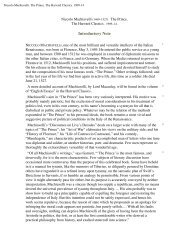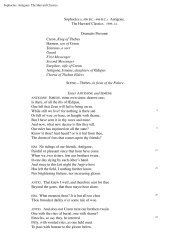Notre Dame de Paris - Bartleby.com
Notre Dame de Paris - Bartleby.com
Notre Dame de Paris - Bartleby.com
You also want an ePaper? Increase the reach of your titles
YUMPU automatically turns print PDFs into web optimized ePapers that Google loves.
people, presented the aspect of a lake into which five or six streets, like so many river mouths, were each<br />
moment pouring fresh floods of heads. The ever-swelling waves of this multitu<strong>de</strong> broke against the<br />
angles of the houses, which projected here and there, like promontories, into the irregular basin of the<br />
Place.<br />
In the center of the high Gothic 6 faça<strong>de</strong> of the Paladins was the great flight of steps, incessantly<br />
occupied by a double stream ascending and <strong>de</strong>scending, which, after being broken by the intermediate<br />
landing, spread in broad waves over the two lateral flights.<br />
Down this great staircase the crowd poured continuously into the Place like a casca<strong>de</strong> into a lake, the<br />
shouts, the laughter, the trampling of thousands of feet making a mighty clamor and tumult. From time to<br />
time the uproar redoubled, the current which bore the crowd towards the grand stairs was choked, thrown<br />
back, and formed into eddies, when some archer thrust back the crowd, or the horse of one of the<br />
provost’s men kicked out to restore or<strong>de</strong>r; an admirable tradition which has been faithfully han<strong>de</strong>d down<br />
through the centuries to our present gendarmes of <strong>Paris</strong>.<br />
Every door and window and roof swarmed with good, placid, honest burgher faces gazing at the<br />
Paladins and at the crowd, and asking no better amusement. For there are many people in <strong>Paris</strong> quite<br />
content to be the spectators of spectators; and to us a wall, behind which something is going on, is a<br />
sufficiently exciting spectacle.<br />
If we of the nineteenth century could mingle in imagination with these <strong>Paris</strong>ians of the fifteenth century,<br />
could push our way with that hustling, elbowing, stamping crowd into the immense Hall of the Paladins,<br />
so cramped on the 6th of January, 1482, the scene would not be without interest or charm for us, and we<br />
would find ourselves surroun<strong>de</strong>d by things so old that to us they would appear quite new.<br />
With the rea<strong>de</strong>r’s permission we will attempt to evoke in thought the impression he would have<br />
experienced in crossing with us the threshold of that great Hall and amid that throng in surcoat, doublet,<br />
and kirtle.<br />
At first there is nothing but a dull roar in our ears and a dazzle in our eyes. Overhead, a roof of double<br />
Gothic arches, paneled with carved wood, painted azure blue, and diapered with gol<strong>de</strong>n fleer <strong>de</strong> lies;<br />
un<strong>de</strong>rfoot, a pavement in alternate squares of black and white. A few paces off is an enormous pillar, and<br />
another—seven in all down the length of the hall, supporting in the center line the springing arches of the<br />
double groaning. Around the first four pillars are stalls all glittering with glassware and trinkets, and<br />
around the last three are oaken benches, worn smooth and shining by the breeches of the litigants and the<br />
gowns of the attorneys. Ranged along the lofty walls, between the doors, between the windows, between<br />
the pillars, is the interminable series of statues of the rulers of France from Pharaoh downward; the<br />
“‘Roils fainéants,” with drooping eyes and indolent hanging arms; the valiant warrior kings, with head<br />
and hands boldly uplifted in the sight of heaven. The tall, pointed windows glow in a thousand colors; at<br />
the wi<strong>de</strong> entrances to the Hall are richly carved doors; and the whole—roof, pillars, walls, cornices,<br />
doors, statues—is resplen<strong>de</strong>nt from top to bottom in a coating of blue and gold, already somewhat<br />
tarnished at the period of which we write, but which had almost entirely disappeared un<strong>de</strong>r dust and<br />
cob-webs in the year of grace 1549, when Du Broil allu<strong>de</strong>d to it in terms of admiration, but from hearsay<br />
only.<br />
Now let the rea<strong>de</strong>r picture to himself that immense, oblong Hall un<strong>de</strong>r the wan light of a January<br />
morning and inva<strong>de</strong>d by a motley, noisy crowd, pouring along the walls and eddying round the pillars,










